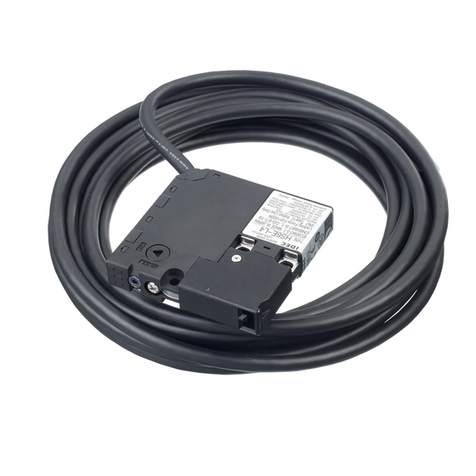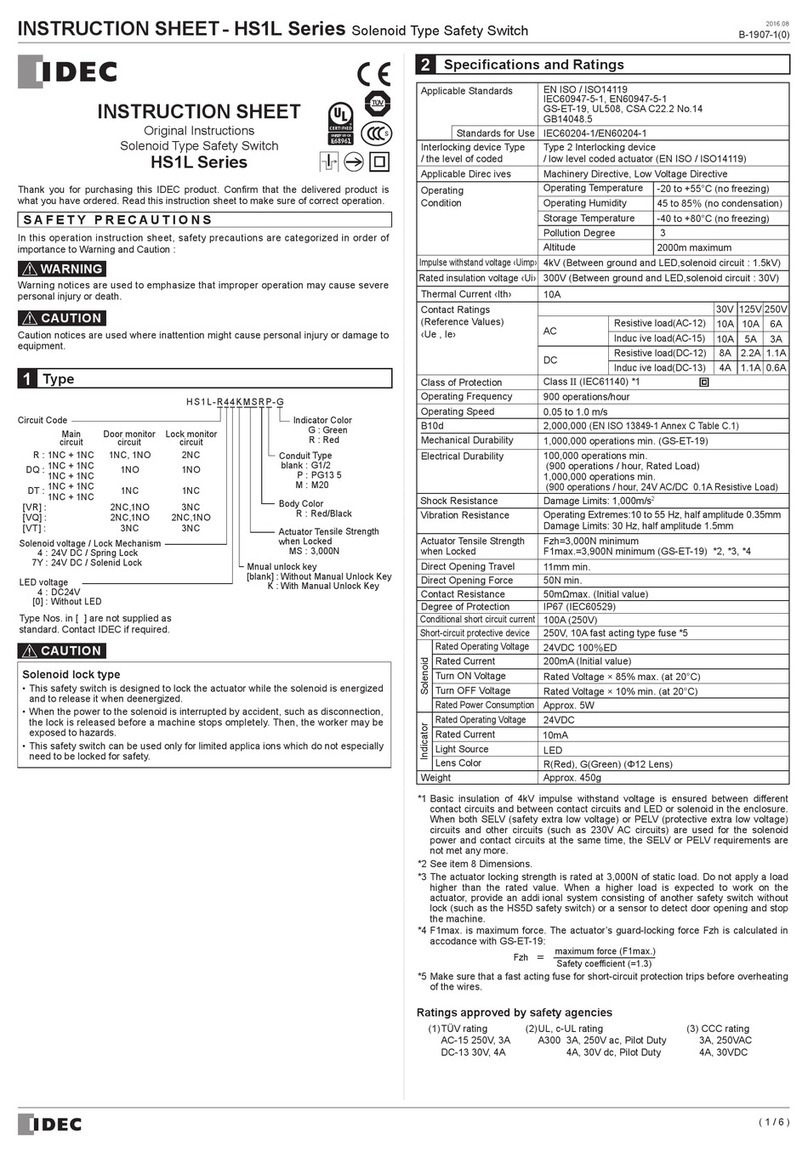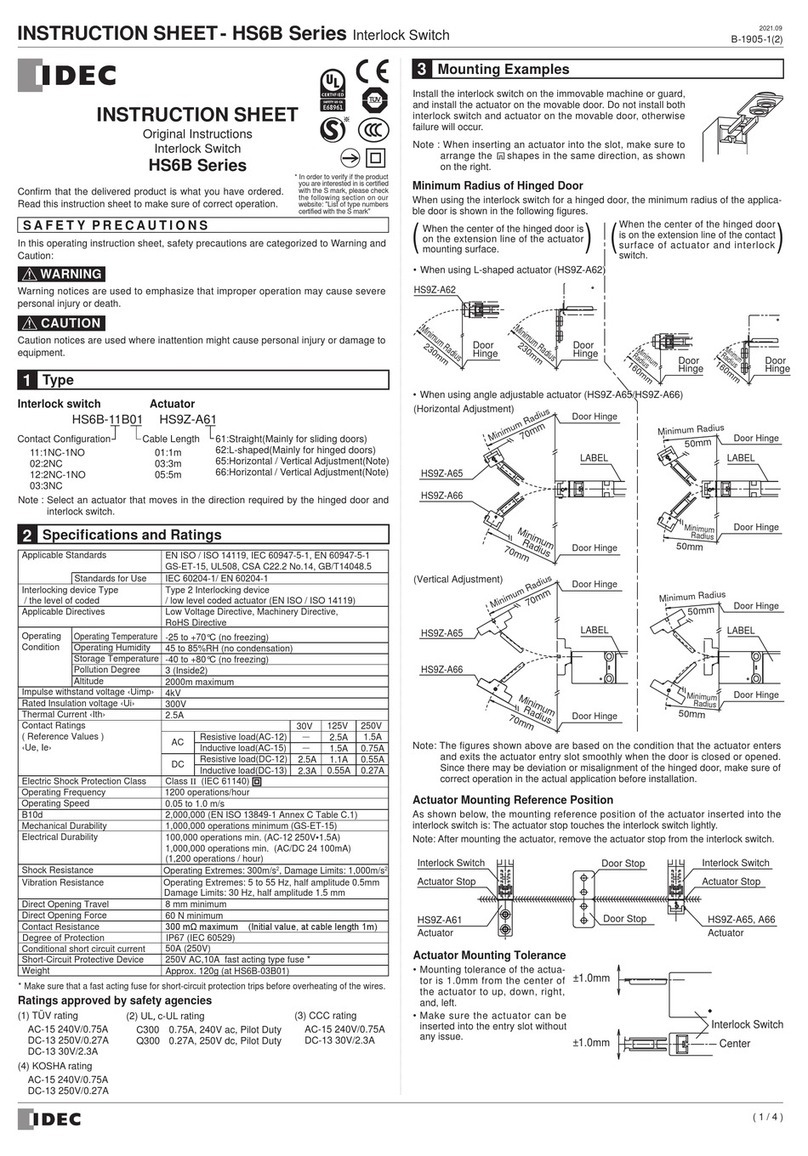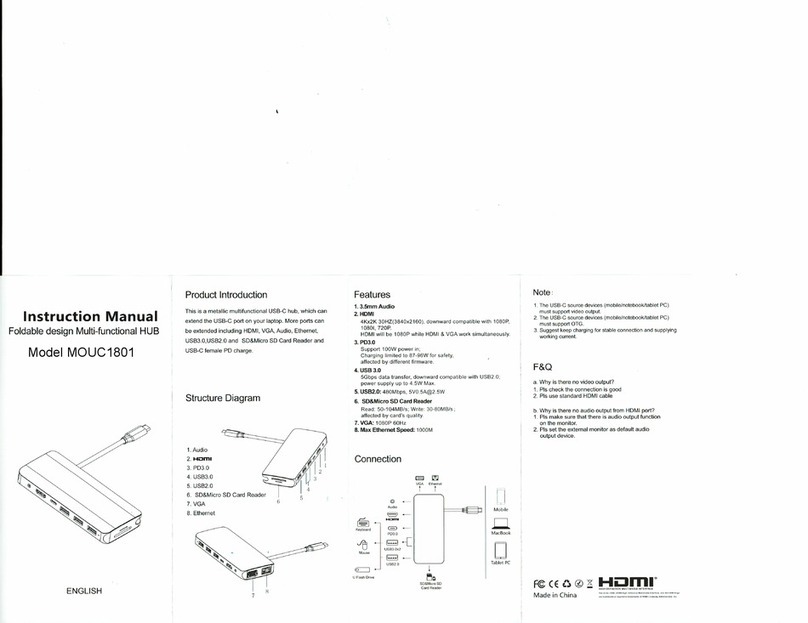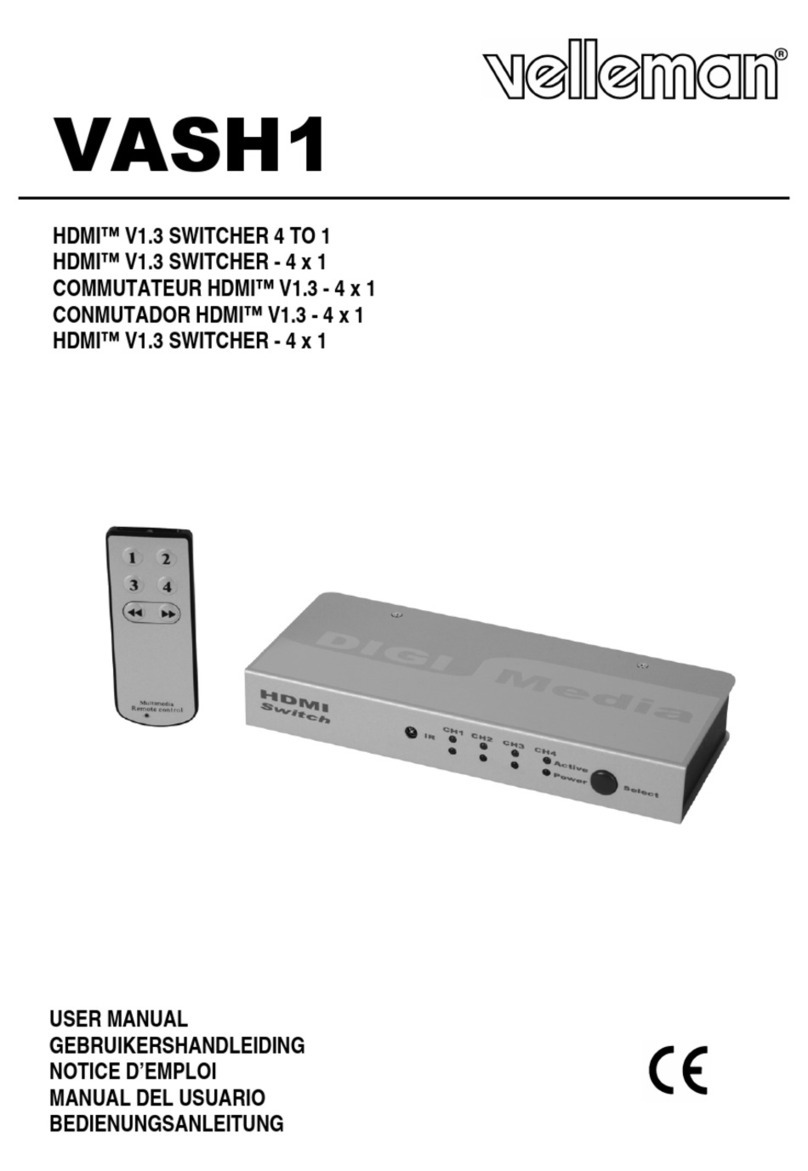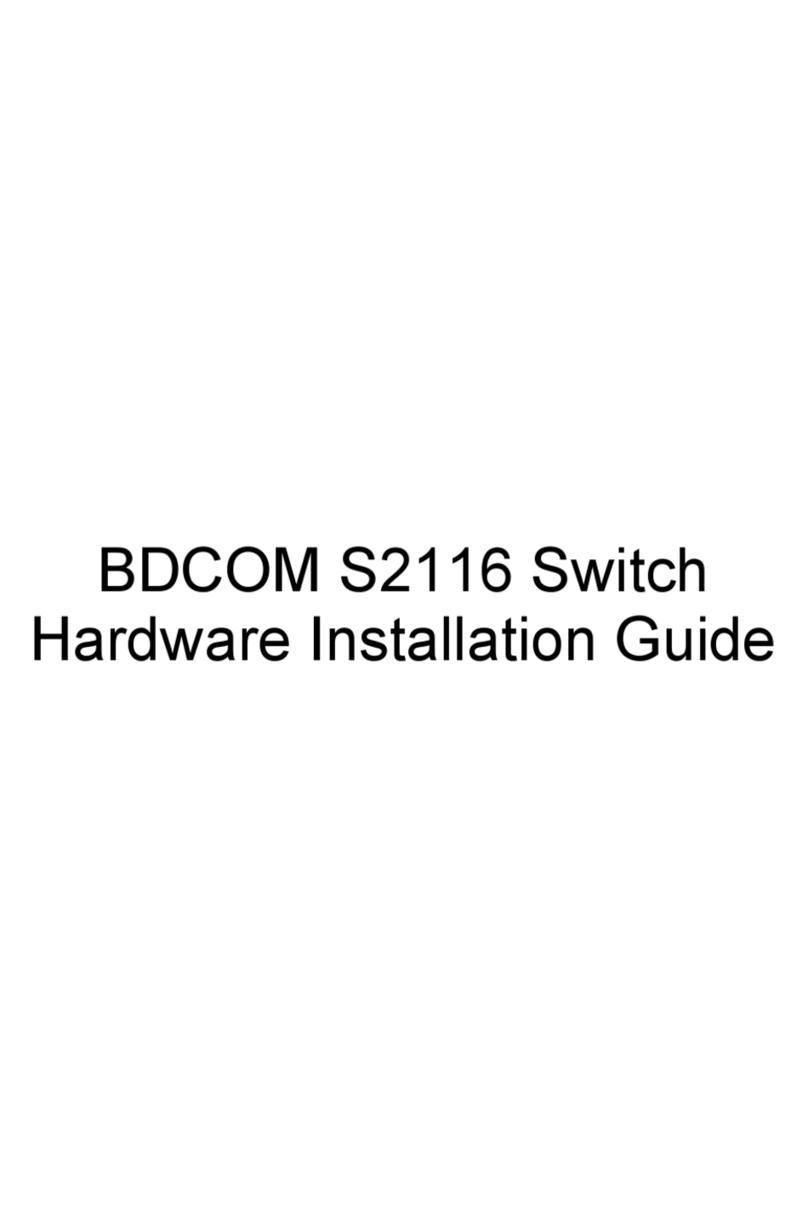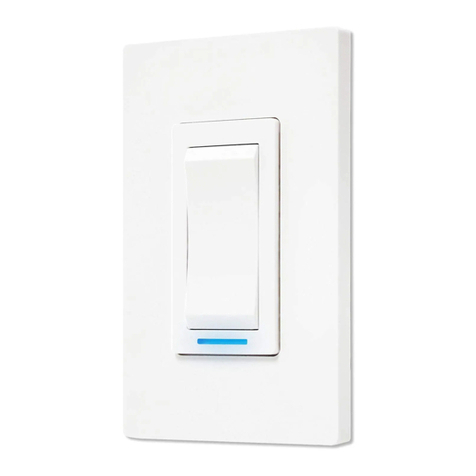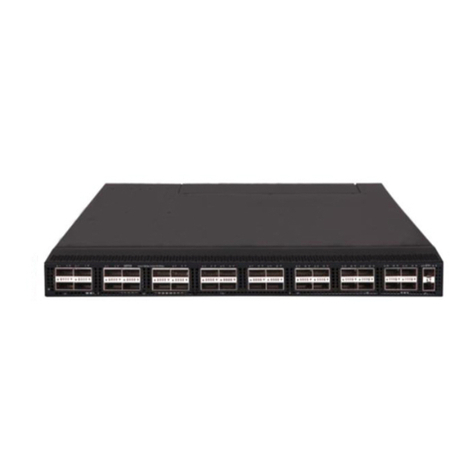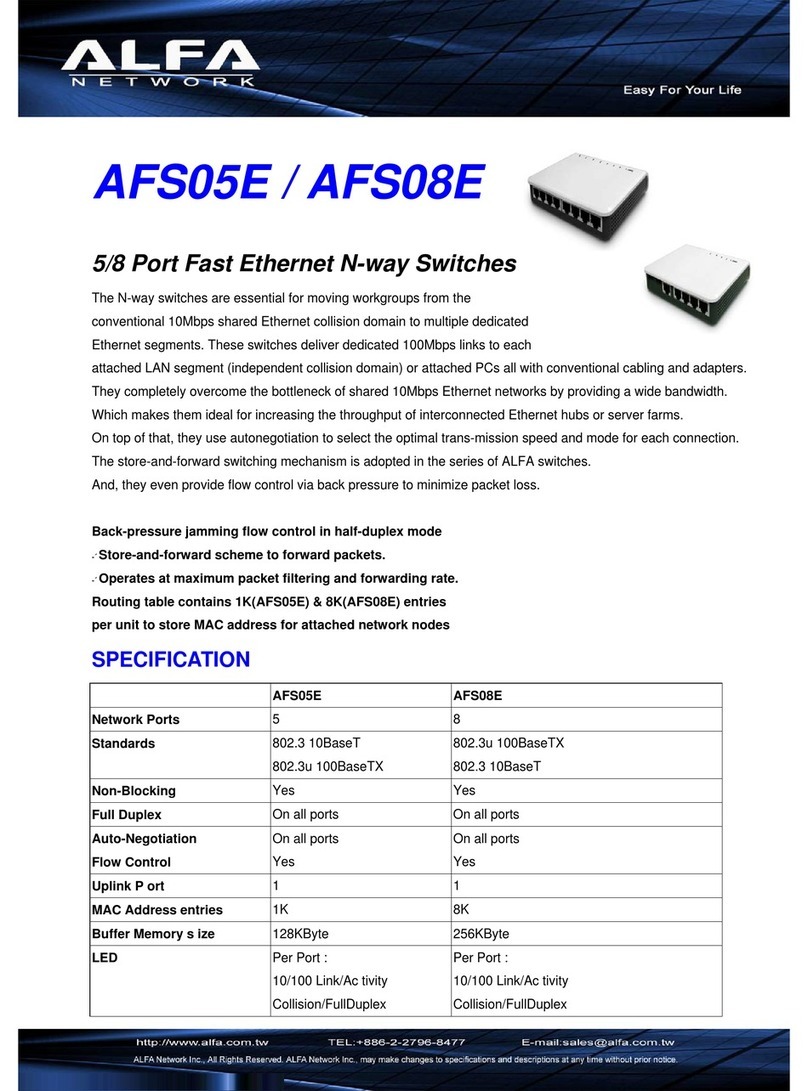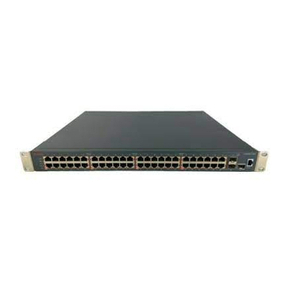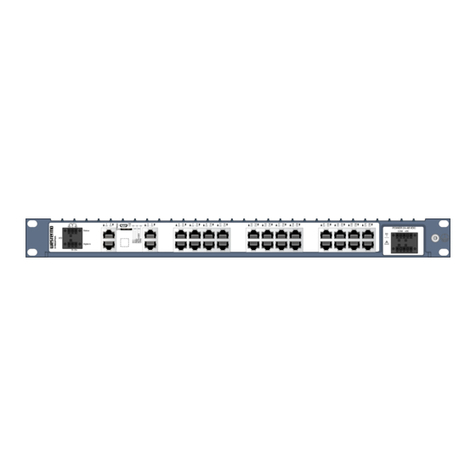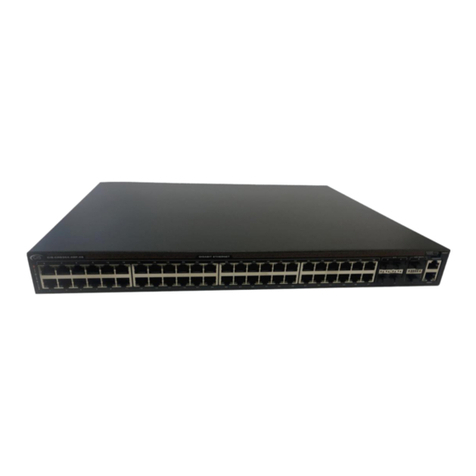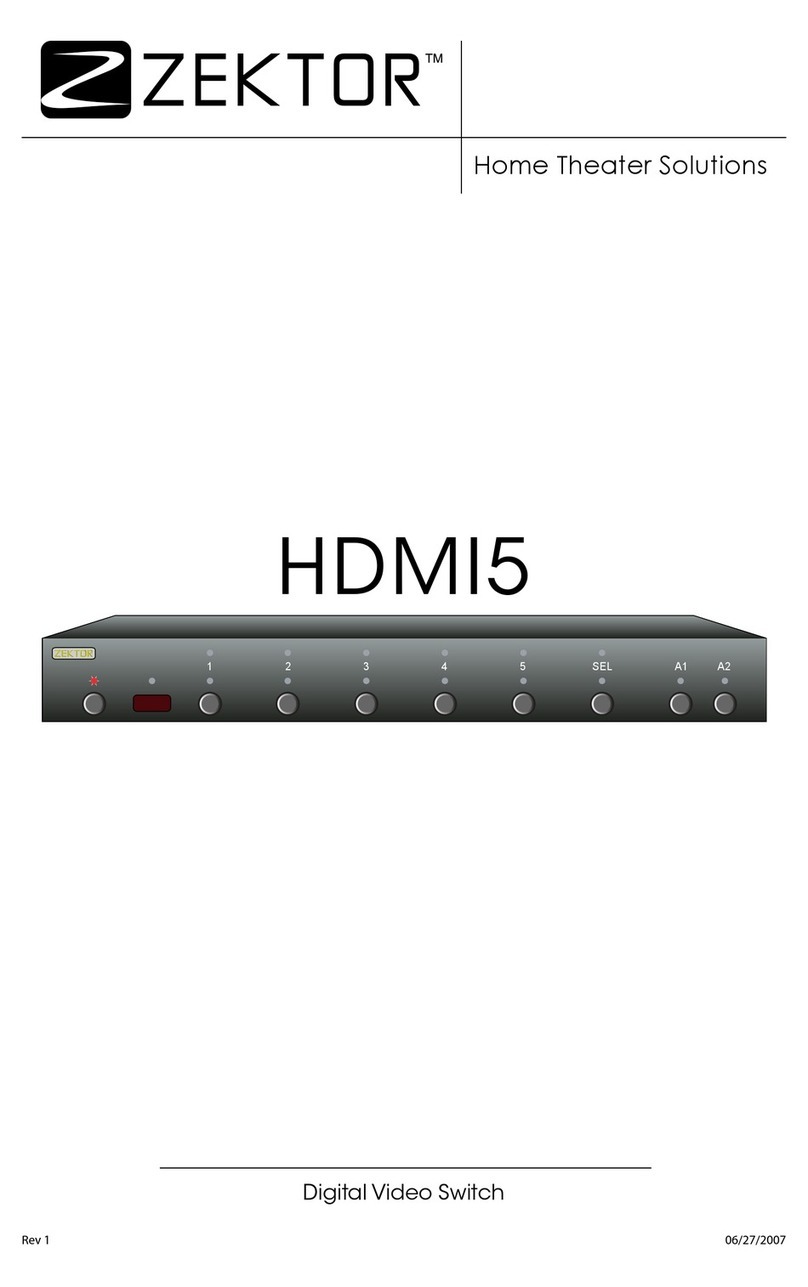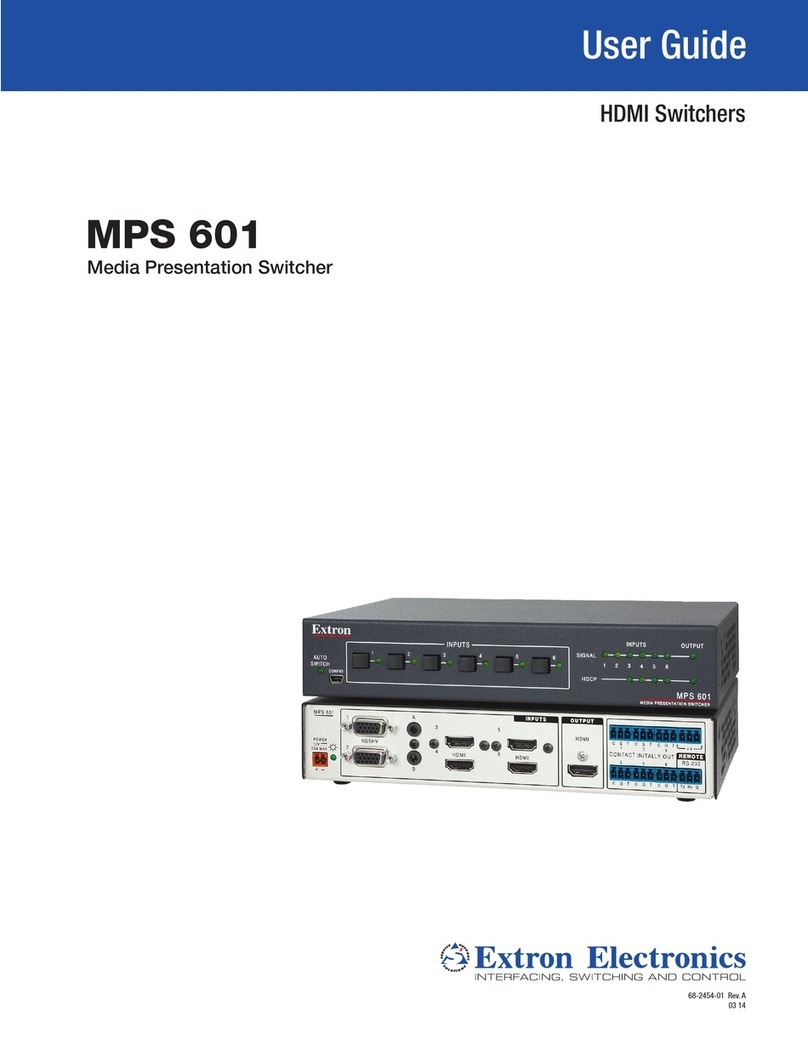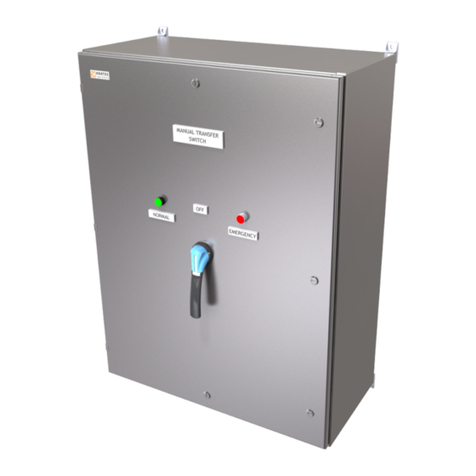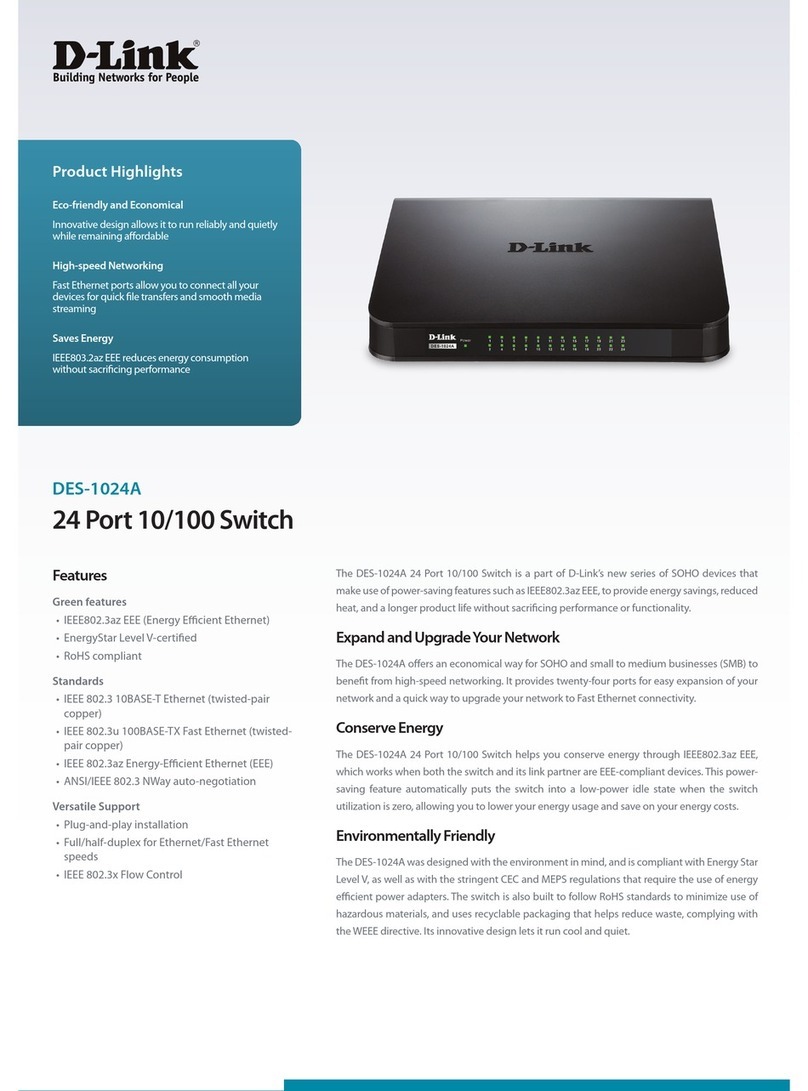IDEC HS1T Series User manual

B-2048-1(1)
INSTRUCTION SHEET - HS1T Series Solenoid Type Safety Switch
( 1 / 9 )
2019.07
2Specifications and Ratings
*2 Ratings approved by safety agencies
(1)TÜV/CCC rating AC-15 250V/0.75A
DC-13 30V/1.0A
(2)UL , c-UL rating 0.75A, 250V ac, Pilot Duty
1A, 30V dc, Pilot Duty
The M20 threaded opening must be filled by a Listed or
Recognized Component Liquid-Tight Flexible Cord Fitting
in order to maintain the Tye 4X Indoor use only rating.
*3 Basic insulation of 2.5kV impuise withstand circuits and between contact circuit
SELV(safety extra low voltage) or circuits (such as 230V AC circuits) at the same
time, the SELV or PELV arequirements are met any more.
*4 The actuator locking strength is rated at 5000N of static load. Do not apply a load
higher than the rated value. When a higher load is expected to work on the
actuator, provide an additional system consisting of another safety switch without
lock (such as the HS5D safety switch) or a sensor to detect door opening and stop
the machine.
1Type
HS1T-VD44ZLM-G
Solenoid Voltage / Lock Mechanism
4 : 24V DC / Spring Lock
7Y : 24V DC / Solenoid Lock
Pilot Light Rated Voltage
4 : 24V DC
Indicator Color
G : Green
Circuit Code
Rear Unlock Button
Blank : Without Rear Unlock Button
L : Rear Unlock Button
Head material
Z:Metal
CAUTION
Solenoid lock type
•
This safety switch is designed to lock the actuator while the solenoid is energized
and to release it when deenergized.
•
When the power to the solenoid is interrupted by accident, such as disconnection,
the lock is released before a machine stops ompletely. Then, the worker may be
exposed to hazards.
•
This safety switch can be used only for limited applications which do not especially
need to be locked for safety.
Applicable Standards
Applicable Directives
Thermal Current ‹ h›
Contact Ratings
(Reference Values)
‹Ue, Ie›*2
Rated Operating Voltage
Rated Current
Turn ON Voltage
Turn OFF Voltage
Rated Power Consumption
Rated Operating Voltage
Rated Current
Light Source
Illumination Color
Standards for Use
SolenoidIndicator
Operating Condition
Inpulse withstand voltage
‹Uimp›
Raed Insulation voltage‹Ui›
Interlocking device Type
/ the level of coded
Device
Short-circuit Protective
current
Condi ional short circuit
Degree of Protection
Contact Resistance
Direct Opening Force
Direct Opening Travel
when Locked
Actuator Tensile Streng h
Electrical Durability
Mechanical durability
B10d
Operating Speed
Operating Frequency
Class of Protection
DC24V 100% duty cycle
200 mA (initial value)
Rated voltage x 85% maximum (at 20°C)
Rated voltage x 10% minimum (at 20°C)
Approx. 5W
DC24V 100% duty cycle
10 mA
LED
Green
Type 2 Interlocking device
/ low level coded actuator (EN ISO / ISO14119)
EN ISO / ISO14119, IEC60947-5-1, EN60947-5-1,
GS-ET-19,UL508, CSA C22.2 No.14, GB/T 14048. 5
IEC60204-1/EN60204-1
Low Voltage Directive, Machinery Directive
2.5A
AC Resistive load (AC12)
Inductive load (AC15)
DC Resistive load (DC12)
Inductive load (DC13)
30V 125V 250V
- 2.5A 1.5A
- 1.5A 0.75A
2.0A 0.4A 0.2A
1.0A 0.22A 0.1A
Class II (IEC61140) *3
900 opera ions/hour
0.05 to 1.0 m/s
2,000,000 (ISO 13849-1 Annex C Table C.1)
2,000,000 operations minimum (GS-ET-19)
The Rear Unlock Button: 3000 operations
minimum (Type HS1T-□L)
100,000 operations min. (AC-15 250V/0.75A)
2,000,000 operations min. (AC/DC 24V 100mA)
(900 operations / hour)
Fzh=5,000N minimum
F1max=6500N minimum (GS-ET-19) *4, *5
12 mm minimum
120N minimum
50 mΩ maximum (initial value)
IP67 (IEC60529) , Type 4X Indoor Use Only
50A(250V)
Use 250V / 10A fast acting type fuse *6
Operating Temperature
Operating Humidity
Pollution Degree
Altitude
2.5kV
(Between ground and LED, solenoid circuit : 0.5kV)
250V (Between ground and LED, solenoid circuit : 30V)
-25 to +55
°C (no freezing)
20 to 95%RH
(no condensation)
3 (Inside 2)
2000m maximum
Thank you for purchasing this IDEC product. Confirm that the delivered product is
what you have ordered. Read his instruction sheet to make sure of correct operation.
In this operation instruction sheet, safety precautions are categorized in order of
importance to Warning and Caution :
Warning notices are used to emphasize that improper operation may cause severe
personal injury or death.
Caution notices are used where inattention might cause personal injury or damage to
equipment.
INSTRUCTION SHEET
Original Instructions
Solenoid Type Safety Switch
HS1T Series
S A F E T Y P R E C A U T I O N S
CAUTION
WARNING
Shock Resistance
Vibration Resistance
Operating Extremes: 100m/s2, Damage Limits: 1000m/s2
Operating Extremes:10 to 55 Hz, half amplitude 0.35mm
Damage Limits: 30 Hz, half amplitude 1.5mm
Conduit Cover
M : Standard type (M20)
SM : Cable side-routed type (M20)
Standard typeContact Congifiguration
*1 Only type No. on √ mark are supplied
as standard.
Contact IDEC for the other if required. Spring Lock Type Solenoid Lock Type
Main
circuit
-
-
-
-
-
-
-
-
-
-
-
-
-
-
1NC+1NC
1NC+1NC
-
-
1NC+1NC
1NC+1NC
1NC+1NC
1NC+1NC
1NC+1NC
1NC+1NC
1NC+1NC
1NC+1NC
-
-
-
-
-
-
-
-
HS1T-□
7Y4ZM-G
√
-
-
√
√
-
-
√
√
√
-
-
-
-
-
-
-
-
-
-
-
-
-
-
-
-
-
-
-
-
-
-
-
HS1T-□
44ZLM-G
-
-
-
√
√
-
-
√
-
-
-
-
-
-
-
-
-
-
-
-
-
-
-
-
-
-
-
-
-
-
-
-
-
HS1T-□
44ZM-G
√
-
-
√
√
-
√
√
-
-
√
√
√
√
√
-
-
-
-
-
-
-
-
-
-
-
-
-
-
-
-
-
-
Door monitor
circuit
1NC
2NC
1NC,1NO
-
1NC,1NO
1NC,1NO
2NC
2NC
3NC
2NC,1NO
1NC
1NC
1NO
1NO
-
1NO
-
1NO
1NO
1NC
1NC
2NC
1NC,1NO
-
-
1NO
1NO
1NC
1NC
2NC
1NC,1NO
-
-
Lock monitor
circuit
1NC
-
-
2NC
1NC,1NO
2NC
1NC,1NO
2NC
1NC
1NC
3NC
2NC,1NO
3NC
2NC,1NO
-
1NC
1NC,1NO
1NO
1NC
1NO
1NC
-
-
2NC
1NC,1NO
1NC,1NO
2NC
1NC,1NO
2NC
1NC
1NC
3NC
2NC,1NO
XD
XF
XG
XH
VA
VB
VC
VD
VF
VG
VH
VJ
VW
VX
DD
XB
XJ
A
B
C
D
F
G
H
J
TA
TB
TC
TD
TF
TG
TH
TJ
Rear Unlock Button
Weight Approx. 450g
Thermal Current‹lth›

B-2048-1(1)
INSTRUCTION SHEET - HS1T Series Solenoid Type Safety Switch
( 2 / 9 )
2019.07
3Mounting Examples
• Install the interlock switch on the immovable machine or guard, and install the
actuator on the movable door. Do not install both interlock switch and actuator on
the movable door, otherwise the angle of insertion of the actuator to the safety switch
may become inappropriate, and failure will occur.
(Examples of Mounting on Sliding Doors)
HS9Z-A11T
Actuator
Door Stop
Latch
HS1T
Safety Switch
Door
(Examples of Mounting on Hinged Doors)
HS9Z-A12T
Actuator
HS1T
Safety Switch
HS9Z-A12T
Actuator
Door
●The HS1T Head
•Changing the Mounting Directions of the HS1T Head
The head of the HS1T can be changed in four directions by pulling up the rota-
tion stopper screw of the HS1T head with a minus driver.
The head rotates in the range of movement as in the diagram below, based on
the mounting direction at the time of shipment.
When
Shipped
Alternative Mounting Direc ions
Range of Movement
of the Head
Attachment Direction
at the Time of Shipment
Rotation Stopper Screw
●How to Change the Mounting Direction
①Rotate the minus driver in he direction
of the arrow and pull up the rotation
stopper screw.
②Once you've pulled up the rotation stopper
screw to its stopping point, rotate the head
to your desired direction.
③When the head has been rotated to your desired mounting direction, align
the △marks of the head and case, and then tighten the rotation stopper screw.
Head
R1
R2
R4
R3
Rotation Stopper Screw
○×
Latch
Fzh
=
maximum force (F1max.)
Safety coefficient (=1.3)
CAUTION
• After installing the rear unlock button, apply Loctite to the screw so that the screw
does not become loose. The lod is made of stainless steel.The rear unlock button
is glass-reinforced PA66 (66 nylon). The mounting screw is iron. Take the
compatibility of plastic material and Loctite into considera ion.
HS9Z-A12T
R1
510 mm
R2
840 mm
R3
270 mm
R4
450 mm
Minimum Radius
CAUTION
• The values shown above are based on the condition that the actuator enters and
exits the actuator entry slot smoothly when the door is closed or opened. Since
there may be deviation or dislocation of the hinged door, make sure of correct
operation in the actual applica ion before installation.
Actuator Mounting Reference Position
As shown below, the mounting reference position of the actuator inserted into the
safety switch is:
(After mounting the actuator, remove the actuator stop from the safety switch.)
• When using the safety switch for a hinged door, the minimum radius of the applicable
door is shown in the following figures.
Minimum Radius of Hinged Door
• Insert the rear unlock indicator
(supplied) in the indicator guide hole on
either the left or right side of the safety
switch and attach the ring part to the
rod on the rear side. After installing the
safety switch on the panel, put the rear
unlock button (supplied) on the rod,
and fasten using the mounting screw
(supplied).
When installing on the aluminum frame
with a thickness of 6mm or more, use
the rear unlock button for the frame kit
(HS9Z-FL5□) sold separately.
The Rear Unlock
Button
Mounting
Screw
(M3 sems screw)
Panel
Rod
When the center of the hinged door is
on the extension line of the actuator
mounting surfase.
When the center of the hinged door is
on the extension line of the contact surface
of actuator and safety switch.
Door Hinge Door Hinge
Minimum
Radius
Minimum Radius
Door Hinge Door Hinge
Minimum Radius
Minimum
Radius
ActuatorCover
Door StopSafety Switch Safety Switch
HS9Z-A11T
Actuator
HS9Z-A12T
Actuator
Door Stop
ActuatorCover
*5 F1max is maximum force. The actuator’s guard-locking force Fzh is calculated in
accodance with GS-ET-19:
*6 Make sure that a fast acting fuse for short-circuit protection trips before
overheating of the wires.
●
Mounting Directions of the HS1T Head
•There is a range of movement to the head. Do not forcibly rotate the head
over its range of movement. There is a risk of damage.
•
There is a risk of damage if the rotation stopper screw is forcibly tightened
without aligning the
△
marks of the head and case.
•
Apply loctite or the like to on the rotation stopper screw to prevent loosening.
•When replacing the HS1T head, make sure that no foreign object enters
into the safety switch.
•Tighten the rotation stopper screw of the head tightly, otherwise the safety
switch may malfunction.
•Don't loosen the rotation stopper screw of the head except when the
mounting directions of the head is changed.
Rear Unlock
Indicator
Indicator Guide Hole
WARNING
Installing the Rear Unlock Button and Indicator
(Type HS1T-□L)

B-2048-1(1)
INSTRUCTION SHEET - HS1T Series Solenoid Type Safety Switch
( 3 / 9 )
2019.07
4Precautions for Operation
(Actuator deviation)+(Door movement)
≤ 3.8mm
≤ 3.8mm
HS9Z-A11T
HS9Z-A12T
For Mounting
• Do not apply an excessive shock to the safety switch when opening or closing the
door. A shock to the safety switch exceeding 1,000 m/s2may cause failure.
• Provide a door guide, and ensure that force is applied on the safety switch only in
the actuator insertion direction.
• Do not pull the actuator while it is locked. Also, regardless of door types, do not use
the safety switch as a door lock. Install a separate lock as shown in section 3.
• Ensure that the safety switch is installed on a flatmounting surface, and provide
sufficient strengthto the mounting surface so that it will not be distorted during
operation. Make sure that no foreign objects are caught between the safety switch
and mounting surface. Uneven surface, distorted surface, or foreign objects may
result in the malfunction of safety switch.
• Entry of foreign objects in the actuator entry slot may affect the mechanism of the
switch and cause a breakdown. If the operating atmosphere is contaminated, use a
protective cover to prevent the entry of foreign objects into the switch
through the actuator entry slots.
• Make sure to install the product in a place where it cannot be damaged.
Make sure to conduct a proper risk assessment evalua ion before using
the product, and use a shield or a cover to protect the product if need be.
• While the solenoid is energized, the switch temperature rises approximately 40°C
above the ambient temperature (to approximately 95°C while the ambient tempera-
ture is 55°C). Keep hands off to prevent burns. If cables come into contact with the
switch, use heat-resistant cables.
• Solenoid has polarity. Be sure to wire correc ly. Do not apply voltage that exceed the
rated voltage, otherwise the solenoid will be burnt out.
• Do not fasten and loosen the conduit at he bottom of the safety switch.
• Use the dedicated actuators only. Other actuators will cause damage to the switch.
• Be careful not to injure yourself with the screwdriver tip when wiring the terminals.
• Be careful not to damage the square-shaped screwdriver port when inserting the
driver into it in order to wire the terminals. Inserting the screwdriver with too much
strength may damage the product.
• Before using the following accessories, be sure to refer to the instruc ion manual for
the respective accessory and follow the instructions in the manual to ensure correct
use. HS9Z-FL5
CAUTION
• HS1T Series Safety Switches are Type 2 low-level coded interlocking devices (EN
ISO / ISO14119). The following system installation & mounting instructions are EN
ISO / ISO14119 requirements to prevent function failure from the interlock switch.
1. Using permanent fixing methods (e.g. welding, rivets, special screws...etc) to
prevent dismantling or de-positioning of the interlock device. However, perma-
nent fixing methods are not an adequate solution if you expect the interlock
device to fail during the machinery lifetime, or if you need to replace the prod-
uct in quick manner. In these situations, other measures (see 2.) should be put
in place to reduce the risks of function failure.
2. At least one of the following measures should be applied to prevent function
failure.
(1) Mounting the interlock device in a place out of reach from workers
(2) Using shielding protection to prevent physical obstruction of the device
(3) Mounting the interlock device in a hidden position
(4) Integrate status monitoring & cycling testing of the device to the control
system to prevent product failure.
• Regardless of door types, do not use the safety switch as a door stop. Install a
mechanical door stop to the end of the door to protect the safety switch against
excessive force.
• Mount the actuator so that it will not hit the operator when the door is open, other-
wise injury may be caused.
• Pay attention to the management of spare actuator. Safety function of door inter-
lock switch will be lost in case the spare actuator is inserted into the interlock
switch. Ensure that the actuator is firmly fastened to the door (welding, rivet, special
screw) in the appropriate location, so that the actuator cannot be removed easily.
• Do not cut or remodel the actuator, otherwise failure will occur.
• If multiple safety components are wired in series, the Performance Level to
ISO13849-1 will be reduced due to the restricted error detection under certain
circumstance.
• The insulation of the cable has to withstand environmental influences.
• The entire concept of the control system, in which the safety component is
integrated, must be validated to ISO13849-2.
• When there is a displacement of safety switch and actuateor, the actuator may hit the
entry slot of safety switch hardly, thus damaging the entry slot and acutuator. The
rubber cushions on the HS9Z actuator prevent the actuator from damaging the entry
slot by absorbing the shock with movement flexibility. Do not, however, exert
excessive shocks, otherwise the failure of safety switch may be caused.
• The rubber cushions may deteriorate depending on the operating enviroment and
conditions. Immediately replace the deformed or cracked rubber cushions with new
ones.
For Type HS9Z-A11T/A12T actuator
Name or Use
For mounting the safety switch (M5 screw) *7
For mounting the cover(M3screw)
For Rotation Stopper Screw of the Head (M4screw)
For mounting the rear unlock button
(M3 sems screw)
For mounting the actuator
(HS9Z-A11T/A12T : two M5 screws) *8
Screw Tightening Torque
3.2 to 3 8 N•m
0.5 to 0.7 N•m
0.1 to 0.3 N•m
0.5 to 0.7 N•m
2.7 to 3.3 N•m
Recommended Screw Tightening Torque
Safety
Switch
Center Center
*7 When the torque is not enough to recommended screw tightening torque, make
sure that the screw do not become loose by using adhesive sealants etc. to
keep right operation and mounting posi ioning.
CAUTION
WARNING
• Turn off the power to the safety switch before starting installation, removal, wiring,
maintenance, and inspection on the safety switch. Failure to turn power off may
cause electrical shocks or fire hazard.
• Do not disassemble or modify the switch. Also do not attempt to disable the
interlock switch function, otherwise a breakdown or an accident will result.
Actuator Mounting Tolerance
• Mounting tolerance of the actuator is 0.5 mm in the four lateral directions.
• Make sure the actuator can be inserted into he entry slot without any issue.
Actuator Mou ting Tolerance
M unting t leran e f the a tuat r is 1 0 mm in the four lateral dire ti ns
• Make sure he actuator can be inserted into he entry slot without any issue
• When closing the door, the actuator is inserted and locked within a certain distance
from the reference position. After the actuator has been locked, the contact operation
is not affected by the actuator movement in the locked state.
HS9Z-A12T
HS9Z-A11T
3.8mm
3.8mm
±0.5mm ±0.5mm
Slot plug
・When not in use, close up the safety switch
actuator entry slots with slot plugs to prevent
dust from entering.
・Actuator entry slots on the front come closed up
wi h slot plugs at time of shipment. When replacing,
please use the tool as shown.
●Installing the slot plug
Rubber Cushions
*8: When rubber cushions (and spacers) are not used, use M6 screws and tighten to a
torque of 4.5 to 5.5 N・m.

B-2048-1(1)
INSTRUCTION SHEET - HS1T Series Solenoid Type Safety Switch
( 4 / 9 )
2019.07
5Contact Operation
(Actuator
Completely Inserted) (Actuator
Pulled Out)
:Contact Closed :Contact Open
Approx. 4 2 (Lock)
0
(Actuator Mounting Reference Position)
Approx.
28.5
Approx
.9.8 Approx.
11.6
(Travel: mm)
Monitor Circuit:
Monitor Circuit:
Monitor Circuit:
(Type HS1T-□4)
The HS1T allows manual unlocking of the actuator to precheck proper door opera-
tion before wiring or turning power on, as well as for emergency use such as a power
failure.
(Type HS1T-□7Y)
If the actuator is not unlocked althoug the solenoid is deenergized, the actuator can
be unlocked manually.
CAUTION
• Before manually unlocking the safety switch, make sure the machine has come to a
complete stop. Manual unlocking during operation may unlock the switch before the
machine stops, and the function of safety switch with solenoid is lost.
• While the solenoid is energized, do not unlock the actuator manually (solenoid lock
type).
• Do not apply excessive force (0.45 N•m or more) to he manual unlock key. Otherwise
the manual unlock switch will be damaged. Do not attach the key to the switch
intentionally (the key is designed to fall off when the operator's hand is off the key).
• Do not leave the manual unlock key attached to the switch during operation. This is
dangerous because the switch can always be unlocked while the machine is in
opera ion.
CAUTION
• Install the HS1T to ensure that a worker can operate the rear unlock button from
inside the safety hedge (the dangerous area). It is dangerous to install the HS5L in
the position where the rear unlock button can be operated from outside the the
safety hedge (the dangerous area), because it is possible to unlock while the
machine is opera ing.
• Use hand to press the button, and do not use a tool. Do not apply excessive force
to the rear unlock button.
• To change the normal position to the
manual unlocking position as shown
above, turn the key fully (90 degrees)
using the special key included with the
switch.
• Using the switch with the key being not
fully turned(less than 90 degrees) may
cause damage to the switch or errors.
• When manually unlocked, the switch will
keep the main and lock monitor circuit
disconnected and the door unlocked.
For Manual Unlocking
Normal
Position Manual
Unlocking
Position
Manual Unlock Key
attached to the
safety switch
Manual Unlock Key Hole
For the Rear Unlock Button and Indicator
(Type HS1T-□L)
• The rear unlock button is used for an emergency escape when he worker is confined in he
safety hedge (the dangerous area).
(The rear unlock button is according to EN ISO / ISO14119, GS-ET-19)
• The lock is released when the rear unlock button is pressed, and the door can be opened.
• To return to the locked status, pull back the button. While the rear unlock button is
depressed, the main circuit remains open and the door is unlocked.
• Each time the rear unlock button is pressed, the indicator is displayed on the side of he
safety switch.
Enables checking of the unlock status from outside he safety hedge.
• Use the rear unlock indicator by attaching it to the display area on either side of the safety
switch.
The Rear Unlock Button
Lock
Release
Rear Unlock StatusNormal Status
●Contact Configuration and Operation
Contact Congifiguration *11
※
9
[
HS1T-TJ
□]
[
HS1T-TG
□]
[
HS1T-TF
□]
[
HS1T-TD
□]
[
HS1T-TC
□]
[
HS1T-TB
□]
[
HS1T-TA
□]
[
HS1T-J
□]
[
HS1T-G
□]
[
HS1T-F
□]
[
HS1T-D
□]
[
HS1T-C
□]
[
HS1T-B
□]
[
HS1T-A
□]
[
HS1T-XB
□]
HS1T-DD
□
HS1T-VG
□
HS1T-VH
□
HS1T-VF
□
HS1T-VD
□
HS1T-VC
□
[
HS1T-VB
□]
HS1T-VA
□
HS1T-XH
□
[
HS1T-XG
□]
[
HS1T-XF
□]
HS1T-XD
□
11
23 24 53 54
42 11-42
23-24
53-54
23
11 24 51 52
42 11-42
23-24
51-52
11
21 22 53
42
54
11-42
21-22
53-54
11
21 22 51
42
52
11-42
21-22
51-52
11
21
33 22
34
42 11-42
21-22
33-34
11
21
31 22
32
42 11-42
21-22
31-32
11
63
51 64
52
42 11-42
51-52
63-64
21
11 42
52 11-42
21-52
23
11 12
24 41
53
42
54
11-12
23-24
41-42
53-54
11
23 24
12 41
51
42
52
11-12
23-24
41-42
51-52
21
11 12
22 53
41
54
42
11-12
21-22
41-42
53-54
21
11 22
12
51
41
52
42
11-12
21-22
41-42
51-52
31
21
11
32
22
12 41 42
11-12
21-22
31-32
41-42
33
21
11
34
22
12 41 42
11-12
21-22
33-34
41-42
11
21 12
22
11-12
21-22
11
23 12
24
11-12
23-24
51
41 52
42 41-42
51-52
11 12 41 42
11-12
41-42
13 14 41 42
13-14
41-42
13 14 53 54
41-42
13-14
53-54
41 42
11 12 51 52
41-42
11-12
51-52
41 42
21
11 22
12 41-42
11-12
21-22
41 42
63
51 64
52 41-42
51-52
63-64
41 42
23
11 24
12 41-42
11-12
23-24
41 42
14 51 52
41-42
13-14
51-52
41 42
13
11 12 53 54
41-42
11-12
53-54
41 42
HS1T-VJ
□
HS1T-VW
□
HS1T-VX
□
11 12
63
51
41
64
52
42
11-12
41-42
51-52
63-64
[
HS1T-XJ
□]
53
41 54
42 41-42
53-54
A1A2
(+) (
-
)
11 12
61
51
41
62
52
42
61
51
41
62
52
42
13 14
13 14
63
51
41
64
52
42
13-14
41-42
51-52
63-64
13-14
41-42
51-52
61-62
11-12
41-42
51-52
61-62
[
HS1T-H
□]
[
HS1T-TH
□]
11 42
51 52
61 62
11-42
51-52
61-62
41 42
51 52
61 62
41-42
51-52
61-62
Type *10 Contact Operation (reference)
Monitor Circuit:
Monitor Circuit:
Monitor Circuit:
Monitor Circuit:
Monitor Circuit:
Monitor Circuit:
Monitor Circuit:
Monitor Circuit:
Monitor Circuit:
Monitor Circuit:
Monitor Circuit:
Monitor Circuit:
Monitor Circuit:
Monitor Circuit:
Monitor Circuit:
Monitor Circuit:
Monitor Circuit:
Monitor Circuit:
Monitor Circuit:
Monitor Circuit:
Monitor Circuit:
Monitor Circuit:
Monitor Circuit:
Monitor Circuit:
Monitor Circuit:
Monitor Circuit:
Monitor Circuit:
Monitor Circuit:
Monitor Circuit:
Monitor Circuit:
Monitor Circuit:
Monitor Circuit:
Monitor Circuit:
Monitor Circuit:
Monitor Circuit:
Monitor Circuit:
Monitor Circuit:
Monitor Circuit:
Monitor Circuit:
Monitor Circuit:
Monitor Circuit:
Monitor Circuit:
Monitor Circuit:
Monitor Circuit:
Monitor Circuit:
Monitor Circuit:
Monitor Circuit:
Monitor Circuit:
Monitor Circuit:
Monitor Circuit:
Monitor Circuit:
Monitor Circuit:
Monitor Circuit:
Monitor Circuit:
Monitor Circuit:
Monitor Circuit:
Monitor Circuit:
Monitor Circuit:
Monitor Circuit:
Main Circuit:
Monitor Circuit:
Monitor Circuit:
Main Circuit:
Monitor Circuit:
Monitor Circuit:
Main Circuit:
Monitor Circuit:
Monitor Circuit:
Main Circuit:
Monitor Circuit:
Monitor Circuit:
Main Circuit:
Monitor Circuit:
Monitor Circuit:
Main Circuit:
Monitor Circuit:
Monitor Circuit:
Main Circuit:
Monitor Circuit:
Monitor Circuit:
Main Circuit:
Monitor Circuit:
Monitor Circuit:
Monitor Circuit:
Monitor Circuit:
Monitor Circuit:
Monitor Circuit:
Main Circuit:
Main Circuit:

B-2048-1(1)
INSTRUCTION SHEET - HS1T Series Solenoid Type Safety Switch
( 5 / 9 )
2019.07
• In applications using ferrules for stranded wires, choose the ferrule listed in the table.
mm2
AI0.5-6WH
AI0.75-6GY
AI1-6RD
TE0.5-8
TE0.75-8
TE1.0-8
0.5
0.75
1
0.5
0.75
1
AWG
AI0.34-6TQ
0.34 20
18
18
20
18
18
22 Phoenix
Contact
Nichifu
Part No. Manufacturer
Applicable wire
(stranded)
6Wiring
Terminal wiring method
• Terminal NO.
‹4 contact type› ‹2 contact type›
• Wire insertion positions, screwdriver insertion positions, and the directions of
screwdriver tip are shown below.
The round-shaped Wire Port
The square-shaped Screwdriver
Port Direction of Screwdriver Tip
Screwdriver Tip
• Contact operation is based on the condition that the actuator is inserted into the
center of the safety switch slot.
• Contact operation shows the HS9Z-A11T/A12T actuator.
• Use main circuit or monitor circuit with for the input to safety circuit.
• Indicator turns on when solenoid is energized.
Note :
• The following type circuits are shipped with jumpers connecting the indicated terminals.
A,B,C,D,F,G,J type circuits: Jumper connecting 12-41
DD type circuit: Jumpers connecting 12-41 and 22-51
• When the NC contacts (11-12)/(21-22) of the door monitor circuit and NC contacts
(41-42)/(51-52) of the lock monitor circuit are connected in series as inputs to the safety
circuit, connect 12-41 or 22-51 before use.
• Wire length and example of layout
• Recommended Wire Core Size : 0.3 to 1.5 mm2(AWG22 to 16)
Routing direction
Wire Length: L1
Type
HS1T-□△*4LM-G
HS1T-□△*4M-G
HS1T-□△*4LSM-G
HS1T-□△*4SM-G
Straight orientation
Straight orientation
Horizontal orientation
30 to 35mm
50 to 55mm
40 to 45mm 8 to 9mm L1
• For wiring, use the following applicable screwdriver.
(Tip shape of the driver is according to the standard of
DIN5264)
0.4
7° to 13°
Φ2.5
2.5
A1
A2
CAUTION
*12 Do not attempt manual unlocking when the solenoid is energized.
*13 Do not energize the solenoid for a long time while the door is open or when the
door is unlocked manually.
CAUTION
*9 This locking monitoring marking has been newly described in section 9.2.1 of
EN ISO / ISO14119. It indicates that any devices with this marking meet the
following EN ISO / ISO 14119 requirements:
- General (- General requirements for guard locking devices) (Section 5.7.1) *
- Locking monitoring (- Locking monitoring for guard locking devices) (Section
5.7.2.2)
When a lock monitor circuit (contact) has the locking monitoring marking, it
means that one circuit (contact) can monitor the position and the locking
function of the protective door. (The locking monitoring circuit (contact) turns
ON only when the protective door is closed and locked.)
*note Both types of HS1T safety switches - spring lock type switches and solenoid
lock type switches - have obtained the locking monitoring certifica ion marking.
Based on risk assessment results, solenoid lock type switches can be used
only for limited applications which do not especially need to be locked for
safety.
*10 Type No. in [ ] are not supplied as standard. See 1. Type for standard.
*11 These are the image of locking position with actuator inserted.
• Solenoid Lock Type (HS1T-□7Y)
Main Circuit
11-42
21-52
Monitor Circuit
11-12
21-22
31-32
Monitor Circuit
13-14
23-24
33-34
Monitor Circuit
41-42
51-52
Monitor Circuit
53-54
63-64
Door is
locked.
The machine
can be
operated.
Door is
unlocked.
The machine
can not be
operated.
The machine
can not be
operated.
Door is
unlocked.
The machine
can not be
operated.
Open
OFF/ON
*13
Closed
Turn the
key to unlock
position
Turn he
key to lock
position
Returned
status
When
operating
the Button
Closed
Closed Closed Closed
Closed
Closed
Closed Closed Closed
Open Open Open
Open
Open Open Open
Open Open Open
Open
OFF
*12 *13
Manual
Unlock Key
Rear Unlock
Button
Closed
OFFON
Closed
Turn the
key to lock
position
Turn the
key to lock
posi ion
Returned
status Returned
status
Door States
Solenoid
Power
A1-A2
Operation Cycle
• Spring Lock Type (HS1T-□4)
Manual
Unlock Key
Rear Unlock
Button
Main Circuit
11-42
21-52
Monitor Circuit
11-12
21-22
31-32
Monitor Circuit
13-14
23-24
33-34
Monitor Circuit
41-42
51-52
Monitor Circuit
53-54
63-64
Door is
locked.
The machine
can be
operated.
Door is
unlocked.
The machine
can not be
operated.
The machine
can not be
operated.
Door is
unlocked.
The machine
can not be
operated.
Closed Open
OFF ON ON/OFF
Closed Closed
OFF
Turn the
key to lock
position
Turn the
key to unlock
position
Turn the
key to lock
posi ion
Turn he
key to lock
position
Returned
status Returned
status Returned
status
When
operating
the Button
Closed
Closed Closed Closed
Closed
Closed
Closed Closed Closed
Open Open Open
Open
Open Open Open
Open Open Open
Open
Door States
Solenoid
Power
A1-A2
21/23/
41/43
22/24/
42/44
11/13/
51/53 12/14/
52/54
31/33/
51/53
32/34/
52/54
21/23/
63 22/24/
64
1211 4241
A1
A2 A1
A2

( 6 / 9 )
B-2048-1(1)
INSTRUCTION SHEET - HS1T Series Solenoid Type Safety Switch 2019.07
Note : Confirm the outside diameter of the multi-core cable, the connector type
depends on the outside diameter of multi-core cable.
Note : When using ST-M20×1.5, use with gasket GP-M (Type No: GPM20, made by
LAPP).
Note : If you use HS1T as Type 4X Indoor Use Only, please use M20 connectors that are
certified the following.
Plastic connector: Type 4,4X, 6 or 6P
Metal connector: Type 4X or 6P
Note : To unwire the terminals, disassemble the product in the following order:
turn off the power → loosen connecter B → remove the terminal cover →
remove the waterproof gasket from connecter A* → loosen connecter A
* Please remove the water-proof gasket carefully with tools such as tweezers.
Be careful when removing the gasket as damages may affect its waterproof
properties. Also, loosening connecter A without removing the gasket first may
damage the cable and provoke connection issues. Please make sure you
re-insert the waterproof gasket properly into connector A when re-assembling
the product.
• Wiring Instructions
1. Insert the applicable screwdriver into
the square-shaped port as shown,until
the screwdriver tip touches the bottom
of the spring.
3. While the screwdriver is retained in
the port, insert the wire or ferrule into
the round-shaped wire port. Each wire
port can accommodate one wire or
ferrule.
Bottom of the Port
Safety Switch
Terminal Cover
Gasket
Connecter
(To buy separately)
How to open conduit port (cable side-routed type)
• Before use, knock in the conduit port where the connector is to be connected, using
a tool such as screwdriver as shown in the figures.
• Before opening the conduit port, remove the terminal cover from the HS1T Safety
Switch main unit, and remove the locking ring for the cable gland installed in the
terminal cover.
• Be sure to remove any crack or burrs on the conduit port, as it will impair waterproof
performance.
Safety switch
Straight orientation Horizontal orientation
Locking ring
for cable gland
Terminal cover
AB
4. Pull out the screwdriver.
The connection is now complete.
2. Push in the screwdriver until it touches
the bottom of the port. The wire port is
now open, and the screwdriver is held
in place. The screwdriver will not come
off even if you release your hand.
The waterproof
gasket is completely
tightening the cable
The waterproof
gasket is not
properly tightening
the cable
Spring Force
Terminal
Spring Force
Terminal
Safety
Switch
A
Gasket
Sheath
B
Terminal
Cover
CAUTION
• Make sure not to lose any screw when
removing the terminal cover from the
switch.
• Please make sure the cable is insterted
deep enough into the terminal cover so
that the waterproof gasket can tighten
he cable sheath completely and ensure
its waterproof functions.
• Make sure you always tighten connecter
A before connecter B, otherwise the
wires which connect the terminals might
get twisted or might break, and this
might also damage the terminal ports.
• When tightening the connecters, only
use a tightening torque that is approved by the connecters' manufacturer to
ensure waterproof properties of the product.
• Do not pull or twist the cable with excessive force, otherwise you might damage the
wires inside of it.
Use a connector with a degree of protection IP67.
Applicable connector dimensions : See the figure on the right.
• When using flexible conduit and metal connector
Applicable Flexible Conduit Example:
Type VF-03 (made by Nihon Flex)
(M20) Applicable Metal Connector Example:
Type RLC-103EC20 (made by Nihon Flex)
• When using plastic connector, metal connector and multi-core cable
(M20) Applicable Plastic Connector Example:
Type ST-M20×1.5 (made by LAPP)
Applicable Metal Connector Example:
Type ALS-□□EC20 (made by Nihon Flex)
9mm max.
Conduit Thread
30mm max.
Applicable Connectors
AB
Connecter (To buy separately)
Gasket
1. Loosen connecter A and connecter B, and insert the cable into these pieces in the
following order :
connecter B → waterproof gasket → connecter A.
Do not tighten the connecters yet.
2. Remove the terminal cover from the switch
and insert the cable into the cover.
3. Wire the terminals.
4. Tighten connecter A into the terminal cover.
Fix the terminal cover back into its original
position. Tighten connector B.
Connecters' mounting method
Correct
The wire is inserted
deep enough
between the clamps
Incorrect
The wire insula ion
sheath is in contact
with the clamps
CAUTION
• When using wire with insulation
diameter of Φ2.0mm or less, do not
insert the wire too deep where the
insulation inserts into the spring clamp
opening. Otherwise conductive failure
will be caused. Make sure that the
wire insulation is stripped 8 to 9 mm
and the wire is inserted to the bottom.
• Please only connect one wire per
terminal port (according to the general
requirements section (13.1.1) of
IEC60204).

B-2048-1(1)
INSTRUCTION SHEET - HS1T Series Solenoid Type Safety Switch 2019.07
( 7 / 9 )
7
Example of wiring Diagram realizing Safety Category
S1: HS1T-VB4 Safety Switch with Solenoid
S2: Starting Switch (HW Series Momentary)
S3: Unlocking Enabling Switch
S4: Safety limit Switch
ESC: Outside start condition
K3, 4: Safety Contactor
F1: Outside fuse of safety relay module at power supply line
Note: Use the monitoring device(Safety relay module) provided the capavility to
detect a cross short circuit. The insulation of the cable has to withstand
environmental influences. If a control device other than the one shown in the
draft is used, the used control device has to be equipped with a cross short
circuit monitor.
Example of a circuit diagram for Safety Category 4
(attainable PL = e)
Output Circuit
HR1S-AF Safety relay module
One of the example of
the circuit ; Safety
relay module, HR1S-AF
series manufactured
by IDEC CORPORATION
HS9Z-A11T Actuator
HS1T-VB4
Safety Switch with Solenoid
Used as open/close
monitor of guard Guard Open
Output Circuit
HR1S-AF Safety relay module
One of the example of
the circuit ; Safety
relay module, HR1S-AF
series manufactured
by IDEC CORPORATION
HS9Z-A11T Actuator
HS1T-VB4
Safety Switch with Solenoid
Used as open/close
monitor of guard Guard Open
Example of a circuit diagram for Safety Category 3
(attainable PL = d)
(Condition 1: To apply the fault exclusion of mechanical structural parts including the actuator
→ Make sure to use the product wi hin the product specification range described in this
manual and he version of the manual provided with he product.)
(Condition 2: Documenta ion of the reason for the machine/equipment manufacturer to have
applied he fault exclusion based on ISO13849-1, ISO13849-2 or IEC62061.)
L1(+)
DC24V
S3
F1
K4
K3
N(−)
DC0V
A1(−)
A2(+)
52
S1
13
14
ESC
K4
K3 S2
51
42
41
S4
1
2
S33 S34 13 23A1
S11 S22
14 24
A2
S12 S21
12
11
24
23
L1(+)
DC24V
S3
F1
K4
K3
N(−)
DC0V
A1(-)
A2(+)
52
S1
12
11
13
14
ESC
K4
K3 S2
51
42
41
24
23
S33 S34 13 23A1
S11 S22
14 24
A2
S12 S21

( 8 / 9 )
B-2048-1(1)
INSTRUCTION SHEET - HS1T Series Solenoid Type Safety Switch 2019.07
Dimensions (mm)
3-M5 Safety Switch
Mounting Holes
Type :HS1T-□4ZSM
Type :HS1T-□4ZM
Type :HS1T-□4ZLM
(For L-type actuators)
8
●Safety Switch dimensions
φ10
(24)
6 5
24 5)
18
3
15 9
Slot Plug
30
40
20
7
45
22
54.9
52.3
(19.1 ±0.5)※
11.5
(16.6 ±0.5)※
22.5
104.6
17.5
104.6
47.1
40
7 1
170
125.540.1
56.2
59.49 20.8
30
φ5.2
4.6 4
61.6
2.5
(5.1±0.5)※
35
(2.6±0.5)※
56.8
(8)
Slot Plug※14
7~8
30
97.8
φ20
20.8
30
40
143
97.840.1
56 2
7 1
59.49 20.8
30
φ5.2
61.6
2 5
(5.1±0.5)※
17.8
35
(2.6±0.5)※
56.8
47.1
(8)
4.6 4
22
φ
5.1
7.7
27
Rear Unlock Indicator
Rear Unlock Button
Rear Unlock Button
(RP)
(RP)
7~8
30
125.5
Main body moun ing hole layout
HS9Z-A12T
Actuator
HS9Z-A11T
Actuator
Slot Plug
(取付基準)
※Actuator center position
30
40
143
97.840.1
56 2
59.49 20.8
30
40
20
6.5
61.6
2.5
17.8
35
56.8
47.1
22
54.9
52.3
(19.1±0.5 )※
11 5
(16.6 ±0.5)※
7 1
(5.1±0.5)※
(2.6±0.5)※
(8)
4.6 4
φ5.2
φ
5.1
φ
5.1
7~8
30
97.8
HS9Z-A11T
Actuator
HS9Z-A12T
Actuator
HS9Z-A11T
Actuator
Main body mounting hole layout
Manual Unlock Key (Supplied)
Main body mounting hole layout
3-M5 Safety Switch
Mounting Holes
(For straight actuators )
3-M5 Safety Switch
Mounting Holes
(RP)
(RP)
(RP)
(RP)
(RP)
(RP)
(RP)
*14 When not in use, close up he safety switch actuator entry slots with slot plugs
to prevent dust from entering.
(Actuator entry slots on the front come closed up with slot plugs at time of shipment.)

( 9 / 9 )
B-2048-1(1)
INSTRUCTION SHEET - HS1T Series Solenoid Type Safety Switch 2019.07
9Precaution for Disposal
Dispose of the HS1T safety switch as an industrial waste.
http://www.idec.com
Manufacturer: IDEC CORP.
2-6-64 Nishimiyahara Yodogawa-ku, Osaka 532-0004, Japan
EU Authorized Representative:APEM SAS
55, Avenue Edouard Herriot BP1, 82303 Caussade Cedex, France
DECLARATION OF CONFORMITY
We, IDEC CORPORATION 2-6-64, Nishimiyahara Yodogawa-ku,Osaka 532-0004, Japan declare
under our sole responsibility that the product:
Description: Safety Switch
Model No: HS1T
to which this declaration relates is in conformity with the EU Directive on the following standard(s)
or other normative document(s). In case of alteration of the product, not agreed upon by us, this
declaration will lose its validity.
Applicable EU Directive : Low Voltage Directive (2014/35/EU)
Machinery Directive (2006/42/EC)
RoHS Directive (2011/65/EU)
Applicable Standard(s) : EN 60947-5-1,GS-ET-19,EN 50581
20.5
11.5
22
40
40
(42.5)
12.3
0.8
43
18.6
3
5.1
φ
5.1
φ
15
90°
22
40
22
43
18.6
479
19.3
0.8
φ5.1
φ
15
When installed on
3
5.1
Actuator Stop
(Supplied with actuator)
When installed on
Actuator dimensions
Type : HS9Z-A11T
(To be sold by separately)
Type : HS9Z-A12T
HS9Z-A11T/A12T Actuator mounting hole layout
2-M5
(Φ5.2 or M5 tapped)
Type :HS1T-□4LSM
(For straight actuators) (For L-type actuators)
Rear Unlock Button
(取付基準)
Slot Plug
(取付基準)
52.3
(19.1 ±0.5)※
11 5
(16.6 ±0.5)※
22.5
104.6
7 1
4.6 4
(5.1±0.5)※
(2.6±0.5)※
47.1
30
22
40
170
125.540.1
56.2
59.49 20.8
30
φ5.2
40
20
7
45
17.5
104.6
61.6
2.535
56 8
(8)
54.9
7~8
30
125.5
φ
20
20.8
Main body mounting hole layout
3-M5 Safety Switch
Mounting Holes
φ
5.1
HS9Z-A12T
Actuator
HS9Z-A11T
Actuator
Rear Unlock Indicator
Rear Unlock Button Rear Unlock Button
(RP)
(RP)
Table of contents
Other IDEC Switch manuals
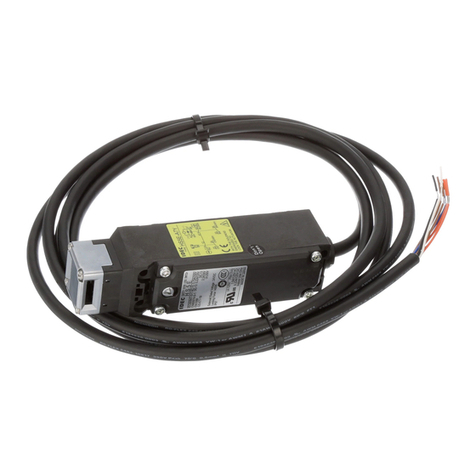
IDEC
IDEC HS5E Series User manual
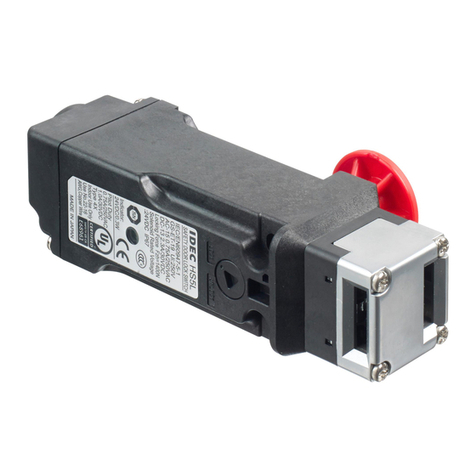
IDEC
IDEC HS5L Series User manual
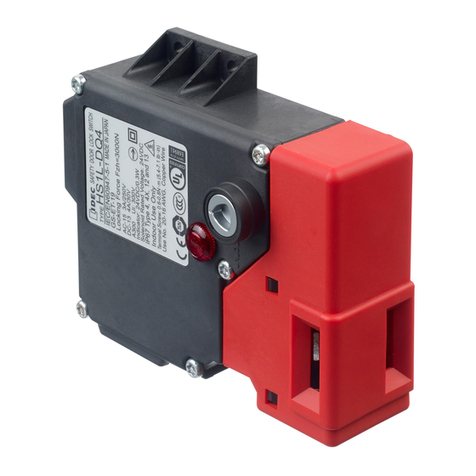
IDEC
IDEC HS1L Series User manual

IDEC
IDEC HS5E Series User manual
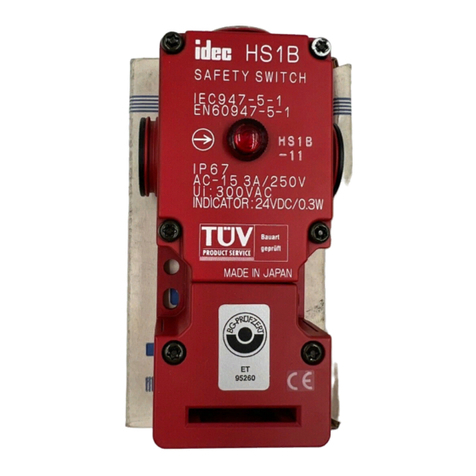
IDEC
IDEC HS1C Series User manual
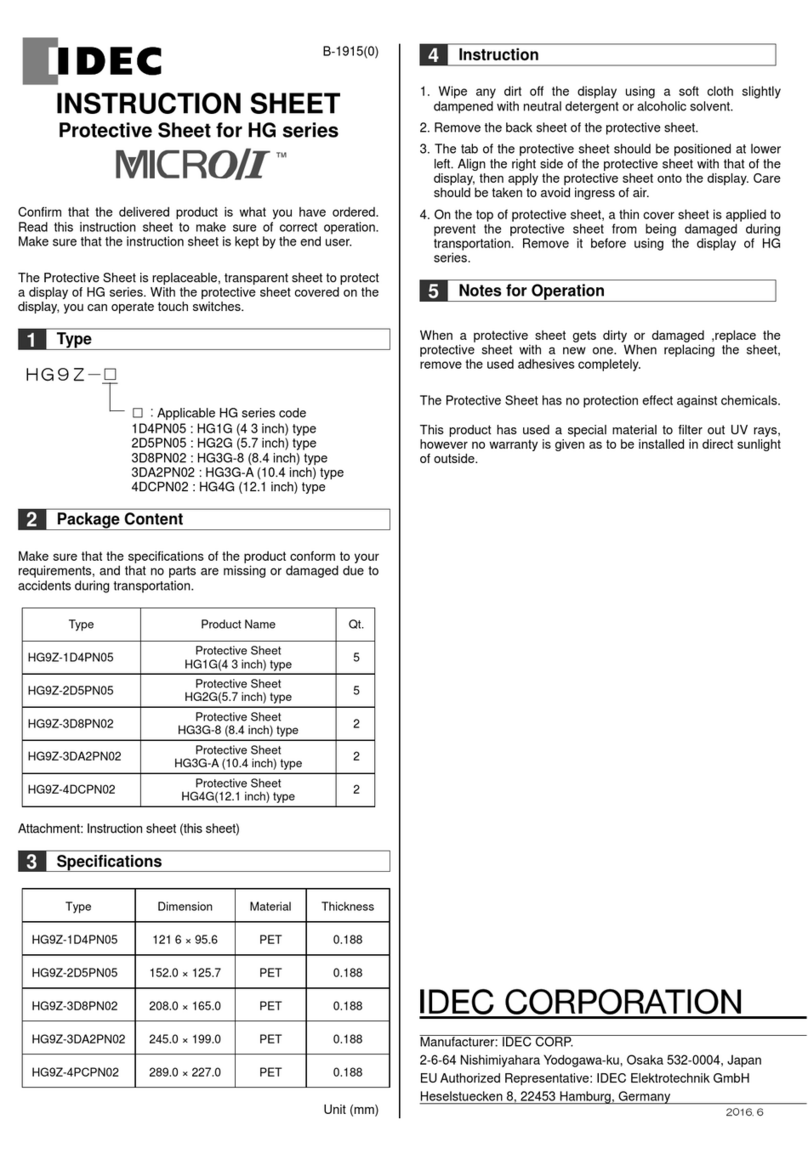
IDEC
IDEC MICRO/I HG9Z-1D4PN05 User manual
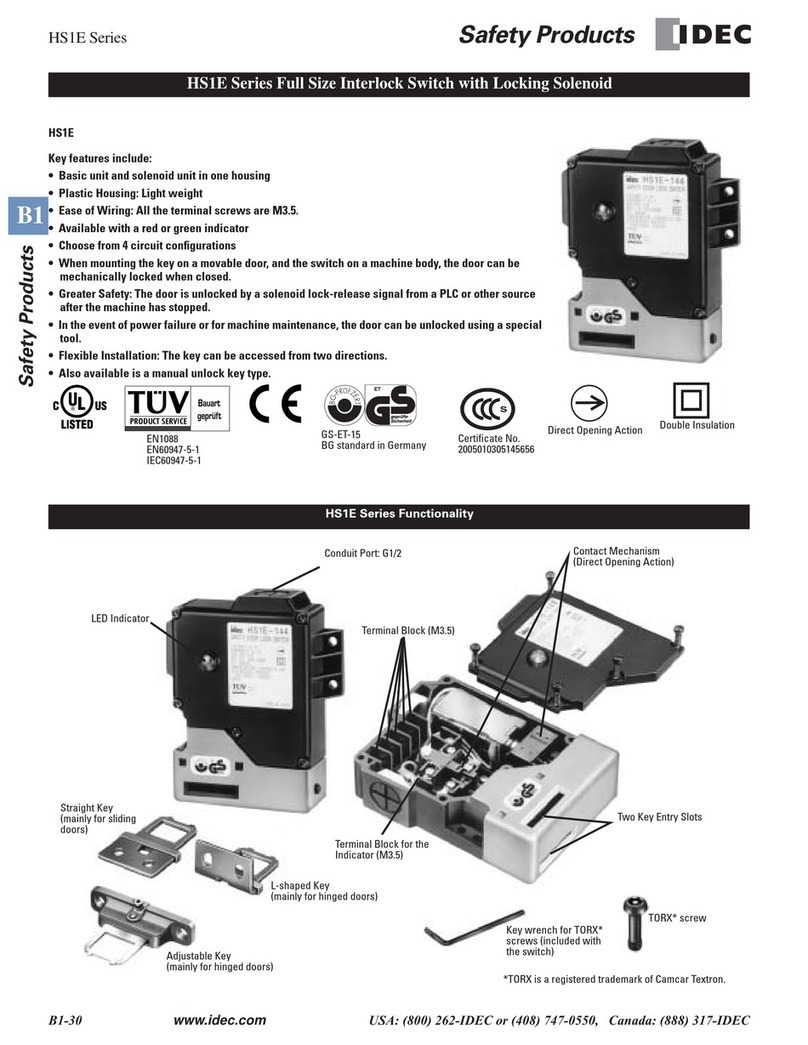
IDEC
IDEC HS1E Series User manual
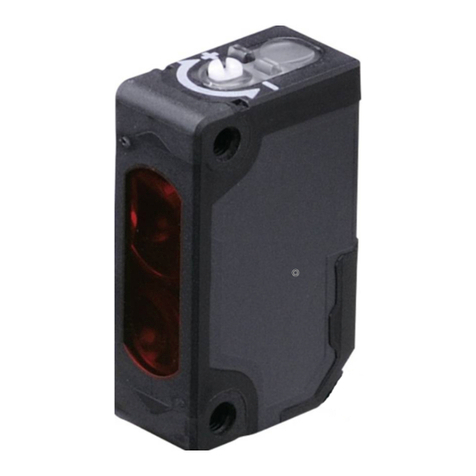
IDEC
IDEC SA1E Series User manual
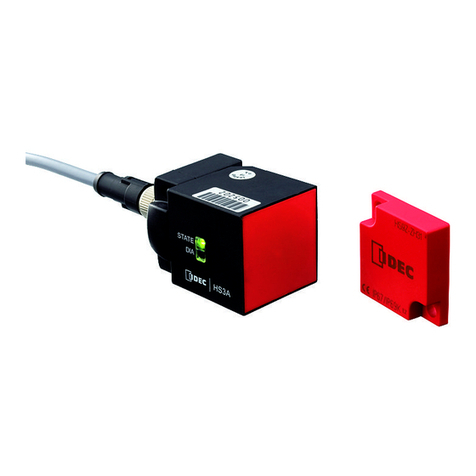
IDEC
IDEC HS3A Series User guide

IDEC
IDEC HS1C Series User manual
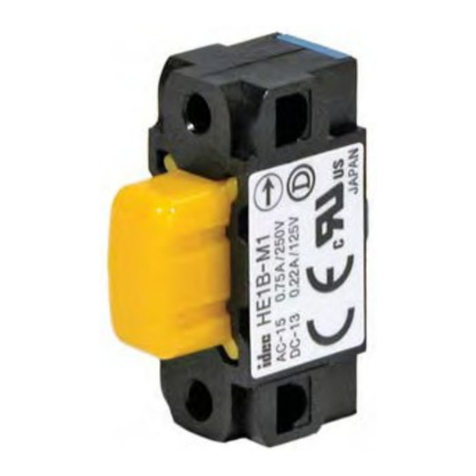
IDEC
IDEC HE1B Series User manual

IDEC
IDEC HS5L Series User manual
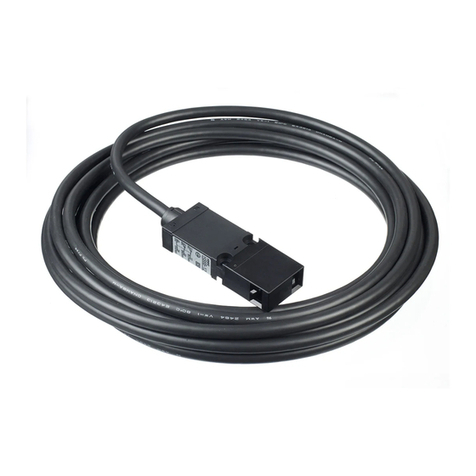
IDEC
IDEC HS6B Series User manual
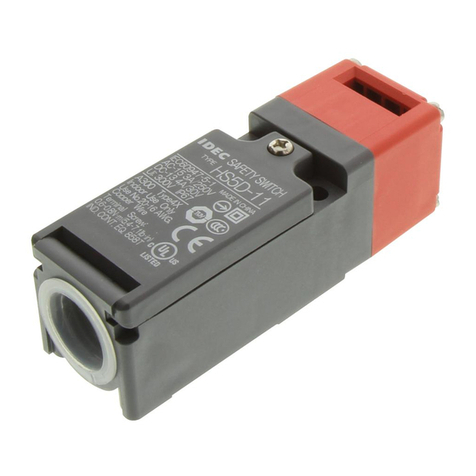
IDEC
IDEC HS5D-11 User manual
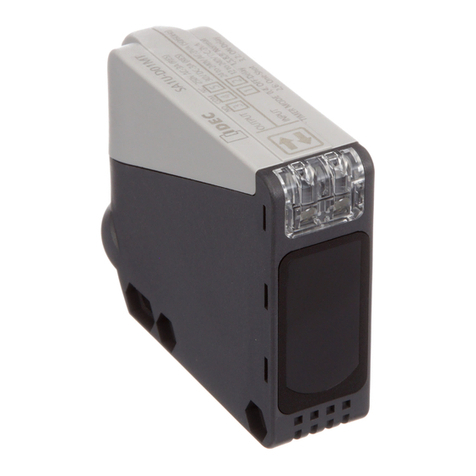
IDEC
IDEC SA1U Series User manual
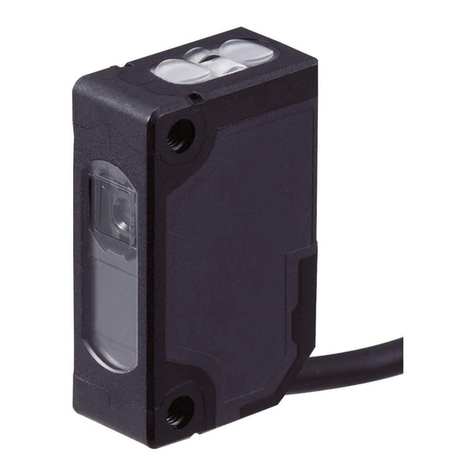
IDEC
IDEC SA1E-L Series User manual

IDEC
IDEC SA1E Series User manual
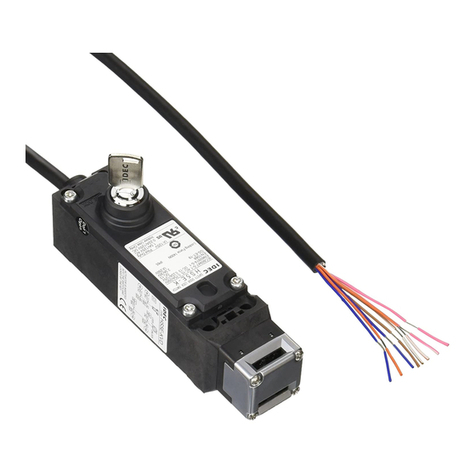
IDEC
IDEC HS5E-K User manual

IDEC
IDEC SX5E Series User manual

IDEC
IDEC HS5E Series User manual

